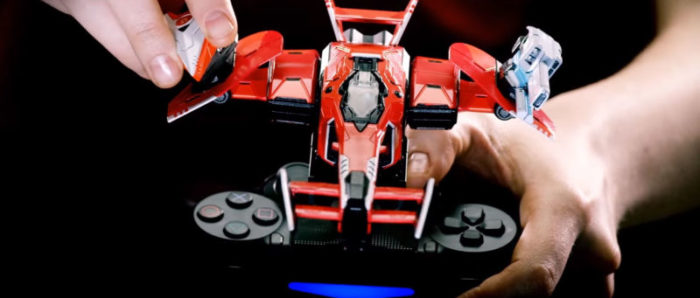During Ubisoft’s E3 2017 conference, it announced a new IP by the name of Starlink: Battle for Atlas where players build their own starships to fight the robot army known as the the Forgotten Legion. The game seems to be mostly centered around its toys to life functionality, wherein sets of starships toys can be collected and mounted onto your console controller to be digitally used in-game.
Each piece you add to your ship’s hull or wings is added to the digital copy in real-time, so when battling some tough enemies you can bring out your big guns (however tiny they are in real life) and clip them to your model to use immediately in combat. A special mount for the Nintendo Switch’s Joy-Con grip was announced, with mounts for the PS4 and Xbox One controllers likely releasing as well since they seem to be shown in the game’s trailer.
As you can see from the trailer below, the ships and the smaller pieces look well made and having them attached directly to your controller would mean seeing a little copy of your ship moving around in your hands while a fully-functioning spacecraft soars through space onscreen, creating a fun and unique toys to life experience.
Since its reveal on Ubisoft’s stage, Starlink has gained the appropriately funny nickname, “No Man’s Skylanders” and a lot of chatter has arisen asking if Ubisoft entering the toys to life market will end up paying out in the long run.
The toys to life market hit its stride back in 2011 when Activision started the Skylander series with Skylanders: Spyro’s Adventure. Since then, five more Skylander entries have been released, with toys upon toys being released that are compatible with the game’s software. As of May 2016, Activision made three billion dollars with over 250 million toys sold, causing other companies to try and get into the market.
Disney was the first that noticed the success in the toys to life market, and launched Disney Infinity in 2013 with tons of toy statues for numerous Disney characters from Star Wars to Pixar. But after only three years, Disney decided to scrap the project and discontinued all Disney Infinity toys causing 300 employees to lose their jobs even though at the time numbers suggested Disney was outselling both Skylanders and other toy to life competitor, LEGO Dimensions.
If the mega-corporation that is Disney decided that the toys to life market was too risky to continue pursuing, that should be a warning for other developers considering staring their own IPs tied to physical toys. Adding in toys has the chance to alienate those players who don’t want to spend the extra money on bonus materials for their ships and instead just want to get through the campaign. The ideal customer for Ubisoft would be one that not only buys the game, but goes all out buying every single accessory for their starship. However, if the majority of players decide the accessories aren’t worth the cash, then Ubisoft risks producing too many toys for the lowered demand and losing any profits it could have gained from the game itself.
How Starlink will be rated would also be a major factor into how the ship models and parts will sell in the long run. Overall, toys to life series are marketed to younger audiences with a main exception being the amiibo figures for Nintendo consoles. Older youths and adults still purchase toys from series like Skylanders, LEGO Dimensions, and Disney Infinity of course, but overall children are the target audience for what toys to life games are trying to sell. If Starlink is able to keep a E rating that will help, but an E+10 or T rating could end up being problematic.
Overall, Ubisoft deciding to break into the toys to life market is surprising but admirable. Mounting the toys onto the controller is unique approach that has us intrigued. Of course, the game itself will also have to be interesting so the toys will seem worth purchasing, and at this point, all we can do is wait to see what else Ubisoft will show of Starlink before its release in Fall 2018. If it does well, maybe we will see a resurgence of confidence for other toys to life series, but if it does poorly then that’s just another nail in the coffin for a genre on its way out the door.













Updated: Jun 12, 2017 11:35 pm